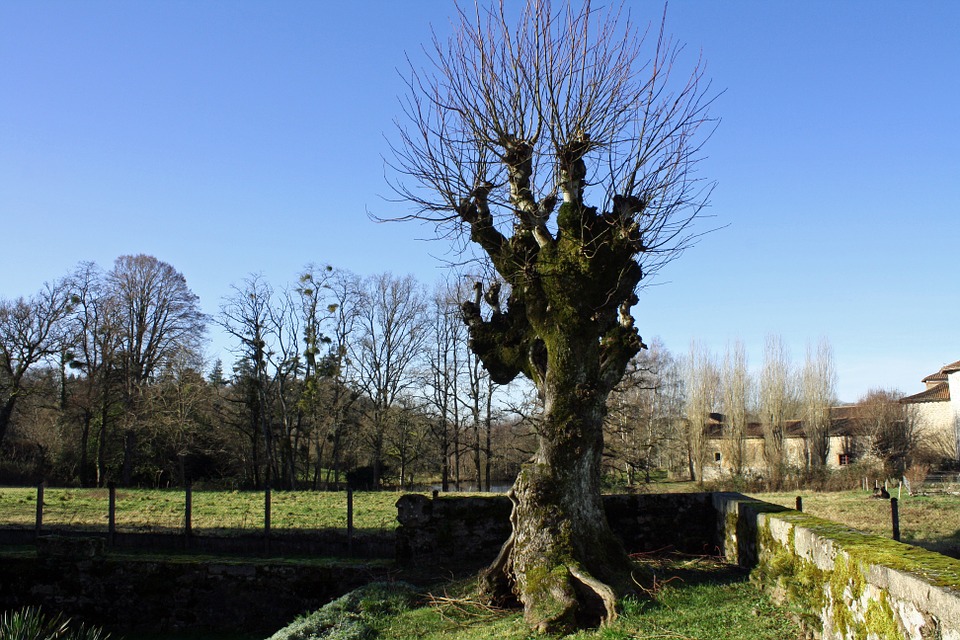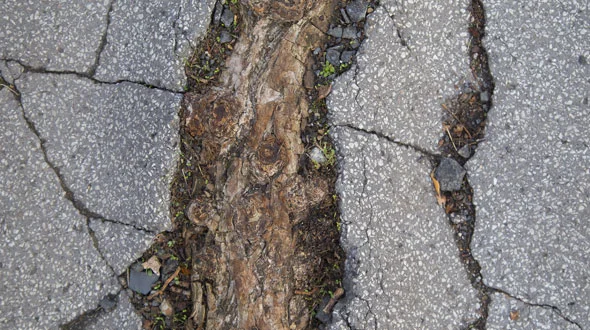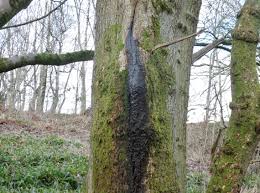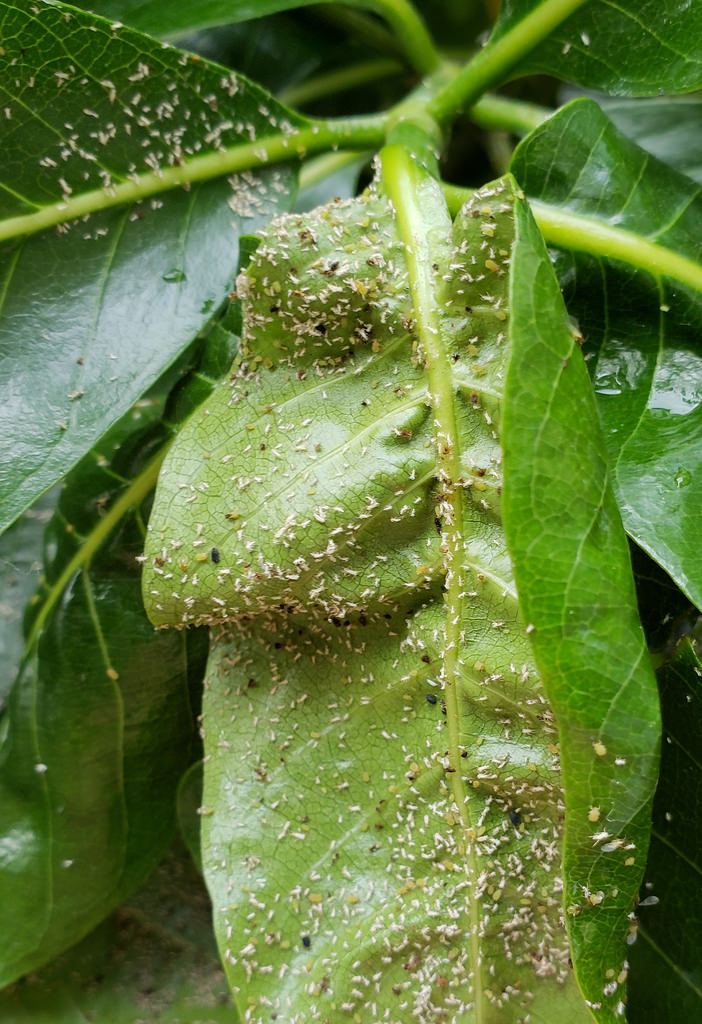
TREE & LAWN CARE BLOG
Is It Safe To Top My Tree?
Driving around Athens, its easy to spot the trees that power companies have hacked off to prevent them getting in the electrical wires. Even some, crepe myrtles being the most picked to prune back the top so heavily it looks as if it was just chopped completely. Topping a tree might be a quick fix but in reality it will eventually result in the trees death, depending on how much was removed.
Why shouldn’t I top my trees?
Tree topping leads to major stress for the tree in Athens, Ga. When you remove all the leaves, you are removing its nutrient source, leading to starvation of the tree, triggering random responses.
The openings from the cuts leave the tree susceptible to pests and other diseases to come in and feed on the tree. At this point, the tree will be under such stress it will not be able to defend it self from such attacks.
Topping leads to response growth, which is when you take the majority of the limbs off the top of the tree and the tree responds by shooting out numerous buds that are very weak in nature and aesthetically unappealing. (picture shown below)
Topping might be a quick fix but will cost much more to maintain later on down the road due to increased pruning costs. The tree will also be very weak and unstable until it its fully healed. Depending on what lies beneath the tree, this can be a potential liability to you or the neighbors around you, if that tree was to fall.
It is shown that well maintained lawn and landscape increases property value anywhere from 16-25%. By topping the tree and not taking the proper pruning measures needed to ensure the health of your trees, you are cutting down on your property value as well.
What alternatives do I have?
The best thing to do is hire a certified Arborist to come out to your property and assess your trees health. We offer free estimates and routine maintenance plans for your landscape in Athens, Ga. It is important while shopping for estimates to keep in mind that having insurance and workers compensation is necessary for you to not be liable for any damages. A certified arborist will also be able to properly identify and diagnose trees with certain diseases or downfalls. Call us today for a free estimate on your trees!
Call now!
How To Protect Your Home From Japanese Beetles
Japanese beetles can cause great damage to your trees and shrubs in Monroe, Ga once they have multiplied. They are able to destroy everything in their path.Since they have arrived in the U.S., they have caused extensive damage in 22 different states. They do not have any enemies to take them out naturally so these little pests must be monitored very closely by a certified Arborist in Monroe, Ga.
How will I know its a Japanese Beetle?
You might recognize their metallic coating carrying different hues of green and copper, however they are only a 1/2 inch long. They carry white patches of hair on their backside that sets them apart from any other beetle. The damage caused by these insects is also very distinguishable, shown below:
As you can see in the picture above, they like to feed on the tissue between the stem and the veins of the leaf, leaving only a skeleton of the leaf behind.
What trees/shrubs are they most likely to feed on?
Japanese beetles aren’t the most picky eaters as they have a large menu they typically enjoy. However, listed below are a few of their favorites:
Crepe Myrtle
American Elm
Japanese Maple
Norway Maple
Plum
Black Walnut
Pin Oak
Rose
American Chesnut
Apple
Crabapple
Hawthorn
Birch
Horsechesnut
How should I treat the affected area?
Removal of the Japanese beetles should be done by a professional to sustain an unhealthy living environment for them. However, if you want to get a head start on the removal you can start by hand picking the beetles off and washing the tree with soapy water. The best time to remove them would be in the morning, while they are the least active. Getting rid of this species for good will take a routine insecticide plan set by a local certified Arborist in Monroe, Ga. This insecticide will be applied only once a year and is very inexpensive. Interested in a free estimate by one of our certified arborists? Click the link below!
I want a free estimate!
Are My Trees Causing Cracks In My Driveway?
Have you noticed a large amount of driveway or sidewalk cracks popping up on your property in Monroe, Ga.? This could be caused by the roots of large trees growing underneath them causing them to crack. But concrete isn’t cheap to replace so how can you prevent this from happening without removing the tree altogether? Our first piece of advice of course will be to plan properly when planting trees not to plant them too close to any type of obstruction that could eventually cause issues including sidewalks, driveways, houses, etc. However there are a few different options if the tree has already started causing issues.
Copper Sulphate -
Depending on what type of tree is causing the damage in Monroe, Ga., and what type of root system it carries underneath it, you might be able to kill the single root that is protruding through the concrete with Copper Sulphate. This is something that should only be performed by professionals, though, as this can damage the soil. Additionally, this only will work if there is a single root that needs to be removed.
Root Pruning -
Root pruning will encourage the roots to grow closer to the trunk of the tree rather than out towards your driveway or sidewalk, involves no chemicals and no damage to the tree whatsoever. This is the most viable option in this situation in Monroe, Ga. However root pruning also, should not be performed by anyone other than a professional as removing too much of a tree’s root system could be potentially fatal to the tree.
Design a Barrier
Once you have removed the root, by either pruning or the Sulphate option, it is important to make a trench or some sort of barrier inbetween the root and the concrete to prevent it from further damaging the concrete. Most home retail stores sell these sort of barriers for weeds at a low price with easy installation. It is important to bury the barrier a few inches into the soil, though, as the roots will grow deep and wide and will be difficult to locate until after a problem has risen.
If you are in Monroe, Ga. and having roots issues with your trees, give us a call for a free estimate on removing the root ad fixing the damage!
Call and Aborist Now! (770) 554-9406
Controlling & Preventing Hickory Bark Beetles.
What are hickory bark beetles?
Hickory bark beetles are a very deadly pest that affect all kinds of Hickory trees in the Athens, Ga. They are about 1/5 inch long with a reddish/brown hue covering its back with few hairs. The difference in male and female bark beetles is the spine. The male will have four spines and the female carries no spines.
What damages do they cause?
The hickory bark beetle is reportedly the most destructive of hickory trees alone. But beware! They have also been known to attack pecan, butternut, shagbark, bitternut & mockernut trees as well, though the hickory is the most common. The larvae cause the most damage, however, as they tunnel in the trunks and large branches. Adults are known to feed on the twigs in the crown, causing major crown die back as well as yellowing and dropping of leaves. Trees under stress from drought, damage, or any other environmental factors are the easiest targets. Below are a few major symptoms to look out for:
Yellowing/ dropping of leaves.
3mm holes in the bark indicating an entrance of pests.
Woodpecker holes in bark
Engraved designs on the inside of the bark, once peeled back.
Crown die-back
Hickory bark beetles are known to carry diseases such as the dutch elm disease, which killed thousands of the american elm’s in the United States over the past few years. As they go from tree to tree, this disease is rapidly spread and very hard to manage and control once emerged. Another fungus associated with this beetle is called Ceratocystis smalleyi, which causes crown die-back and cankers.
How do I get rid of them?
Hickory bark beetles are very deadly and once they have spread, usually the tree will have to be removed all together to be sure none of the other trees become infected as well. However, they are not likely to attack a very healthy tree so the best measure of control to do here is more of a preventative such as pruning regularly, fertilization, regular watering schedules, etc. If you have concerns about bark beetles on your property, be sure to contact your local certified Arborist in Athens, Ga. to confirm diagnosis and begin a treatment plan for the area right away before they spread to other trees.
Questions or concerns? Contact an Arborist now!
Why Is There Slime On My Tree?
Have you noticed any kind of watery or slimy substance coming out of your trees in Lawrenceville, Ga? This is typically identified as bacterial wetwood or slime flux. The primary host for this type of bacteria are the most popular elm trees used in neighborhoods and business complexes. However, this disease has been known to affect a range of other species including hickory, birch, sycamore, cherry, ash, willow, maple, etc.
Causes of Infection
There are a number of different reasons this disease could infect your once healthy trees in Lawrenceville, including simple environmental stress factors. It is primarily caused by a bacterial infection in the inner sapwood and the outer heartwood of the tree. Any type of wound or injury to the tree can cause an infection, as this opens the tree up for disease to enter. Improper planting is another cause, where soil compaction could be a potential issue due to heavy traffic around the tree.
Symptoms of Bacterial Wetwood (Slime Flux)
Constant pungent odors
Bleeding cankers around the base
Water soaked patches on the tree
Slimy substance weeping down the tree
Treatment
Unfortunately, at this time, there are no solid measures that we can take to remove the bacteria other than tall-tale home remedies and better management practices. Here are a few different things to try:
Making sure to prune back all dead or dying branches to prevent the tree from wasting energy.
Make sure the soil around the base is good and has not become compacted.
Water the tree on a regular schedule while it is under stress from the bacteria.
Try home remedies such as dish soap & small amounts of alcohol to disinfect the tree and keep it clean.
A lot of homeowners will notice the pests starting to get around the slime and think, “oh, better get some pesticides to treat the infestation”. We do not recommend doing this at all, as it can potentially damage the tree further. The best thing to do for the trees that have been infected is to keep them clean, and keep them maintained. Some homeowners swear by the dish soap method of cleaning the slim flux off the tree. Simply by using dish soap and water to clean the slime off every couple of days, it acts as a block to the bacteria. Most of the time, the healthy trees will be able to grow new wood around the diseased portion of the tree. Before you take any measures in Lawrenceville, make sure to consult with an Arborist first, to properly identify and diagnose the tree before moving forward with a treatment plan.
Need A Consultation? Call Us Today!
Identifying & Eliminating Aphids
In Watkinsville, Aphids can be hard to identify at first because they are so extremely small and like to hide in places like the underside of a leaf. However, they do tend to multiply very fast and it is important to get them under control at the first sight. They are so tiny, they are almost impossible to see and can be a range of different colors including black, brown, green, etc. Aphids are not picky, in fact, they have many different species that feed on different types of plants such as the rose aphids or the green peach aphids.
Symptoms of Aphids.
Aphids tend to attack more than just one portion of the tree or plant in Watkinsville, Ga. including the leaves, stems, buds, flowers, etc. However they are more prone to attack new growth versus old. Here are some symptoms of an Aphid attack:
The first and most obvious identifier would be the large clusters of aphids on the leaves, stems or buds of the tree or plant. Aphids gather in large colonies in their attacks.
Leaf wilt is another important sign. If your leaves are curling under or turning yellow, flip them over and check for any sign of aphids.
Look for stickiness on the leaves, or sticky droppings falling from the trees, as this is a sign of honeydew & that the aphids have been eating the sap.
If you have a flowering or a fruit producing tree or plant and notice any distortion to the flower or fruit, this could be another indication.
Noticing any bumps on your trees? These are called “galls” and can be caused by Aphids.
Treatment & Prevention.
Now that you have learned all about aphids and signs that you have an infestation, you should know how to treat and control them! There are many different ways to get rid of and prevent a further problem here are a few:
Treatment:
You can manually remove them by pinching them off, one by one.
Cold water is unfavorable to the aphids, try blasting them, not too hard, but with very cold water.
Neem oil is another organic way to rid your trees and plants of the aphids. This is most effective and most widely used on vergetable and fruit gardens.
“Safer Soap” a natural pesticide is also very safe and effective to use in treatment. This will cause dehydration and death of the aphids within hours.
We do not recommend using any type of harmful chemical pesticide unless the infestation is large enough for justification. Botanical insecticides can be bought at local home stores, just be sure to read all the label instructions before use.
Prevention:
Over fertilizing your trees and plants can cause a rapid aphid infestation as the aphids enjoy plants and trees with high nitrogen levels and soft new growth.
While neem oil is used as an all natural treatment for aphids, it is also an effective preventative measure to take before they take over.
Insects such as lacewings, wasps, and lady beetles feed on aphids. You might want to consider placing these insects around or planting some species that they are attracted to near the aphid infestation and let nature take its course!
Aphids can really damage your trees and plants, and sometimes can be harder to get rid of depending on the size of the infestation. It is important to know when a professional should step in and take care of the problem once and for all. Click the link below to get in touch with one of our Arborists in Watkinsville, Ga. for a free estimate!
Tired of the bugs? Call us today for a free quote!
How to Tell If You Have Pine Beetles - & How to Eliminate Them.
It is important to recognize the effects a pine beetle has on a tree before the condition worsens. The worst part is that you might not always be able to tell if there is an infestation. If the infestation is not treated in a timely fashion, the tree will most certainly die. Sometimes the tree can hold its composure through an entire season of an attack with no signs of decline until the following season when it might be too late. There are a few symptoms that may or may not be on the tree including:
The easiest one, the beetles! Any sign of insect activity usually means decay is prominent in the tree trunk for them to feed on. If you notice insects of any kind in Watkinsville, Ga, give our Arborist’s a call for information on how to proceed.
Sawdust - If you notice a reddish sawdust at the base or in the bark of your trees this is most definitely an indicator of a problem! The pine beetles bore their way through the tree leaving behind small amounts of sawdust like material.
Tunneling - Another indicator of pine beetles are the tunnels they leave behind in the bark. Be careful not to remove too much of the bark while checking as this can expose the tree to even more disease and pests.
Woodpeckers: Believe it or not, if you have woodpeckers in your trees in Watkinsville, you most likely have pine beetles. Woodpeckers feed on the larvae of the beetles.
Pitch tubes: Last but certainly not least, pitch tubes are gooey popcorn-looking gunk that ooze out of the tree as a defense mechanism to protect the trees phloem layer.
There are many kinds of pine beetles, and all of them pose a danger to your trees in Watkinsville, Ga. You must act fast! The best way to get rid of pine beetles is with an insecticide our certified Arborists can provide to you. Next, you would want to make sure you set up a plan with your Arborist to proactively treat your trees to protect them from becoming the next victim. However, the treatment for pine beetles works best before the infestation. Call us today for a consultation on your trees from one of our certified Arborists!
Call Now (770) 554-9406
What's The Best Time of Year to Transplant Trees?
Sometimes we plant trees thinking they will be a good fit for a specific area but once the tree has matured a bit we find another location that it would look better in. This happens with clients all the time, usually from spacing issues or landscaper mistakes planting a very large tree too close to a house. Instead of removing the tree altogether, you can perform a transplant! Now transplanting isn’t the easiest of jobs and should definitely be performed by a professional. There are no guarantees that the tree will survive the move , either so it is something a homeowner should be 100% certain they want to do. The biggest part of transplanting is timing! If you try to transplant a tree during the wrong time of the season it can almost guarantee its death. We always recommend transplanting trees during their dormant season, which varies by species. Dormancy is when the trees are not actively growing and have no leaves or flowers, unless of course it is a conifer. Evergreens will not have any new bud growth which is an indicator that the tree is currently dormant. However, you also do not want to transplant the tree in the middle of winter, as you will be risking heavy root damage when there is frost in the soil. In winter, the ground is much harder as well, making it a tough process. Generally the best time to transplant a tree would be in spring, which provides the most ideal soil and weather conditions for the tree. Listed below are some things to keep in mind while doing the transplant:
Get the timing right.
Different species have different requirements for transplanting, for example, your conifer trees such as pine and spruce would prefer to be moved in fall versus spring. If you have questions about transplanting a tree in the Snellville or surrounding areas, be sure to give us a call for a free estimate!
Don’t skip the details.
Just as shrubs and plants, trees have different hardy zones and water, sun requirements that must be met to keep the tree alive! Make sure you do your research on what you are transplanting and what it needs exactly, as the soil and sun exposure might be different in different areas of your lawn. Still have questions? We have more than 3 certified Arborists on staff that can answer all of your tree care needs in Snellville, Ga.
There is no guarantee for survival.
Not all trees react to transplanting the same way and even though mature vs. young trees make no difference in the transplant, they can still be susceptible to death. Make sure to be certain when making a decision on whether or not to move it.
Our best advice is if it doesn’t have to be moved or isn’t causing problems, leave it be and plant another! More trees = more property value!
Call us today to schedule an estimate by one of our certified professionals for a transplant!



















